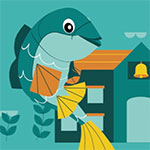Fishing Tips for Beginners
Safety, tips, and knowledge are the basic components of a good angler experience. If you're new to fishing, we have the information you'll need get started and improve your fishing technique.
Beginner Fishing Tips
Catching fish can be a lot of fun; in fact, the catch is why most beginners learn how to fish. But catching is a process, so the better beginners prepare, the more fish they catch. Below are a few beginner fishing tips to help increase those catches.
Safety First
This means angler safety. While most anglers tend to remember items like sunscreen, rain gear, and a first aid kit, beginners tend to forget non-fishing essentials, like bringing along a bottle of drinking water. Or Dramamine for boat trips. Staying healthy and hydrated are key to an enjoyable day of fishing.
Boat Fishing Tips and Tricks
In addition to always wearing a properly rated PFD when on the water, regardless of the size of the boat, space is often limited in small boats. Reeling your catch in to the tip of the rod may prove far more difficult to handle in a boat than on dry land. To make landing your catch easier, leave at least a rod’s worth of line out when reeling in your catch and lift the line itself out of the water. The extra length of line will keep your rod from reacting to the movement of the flopping fish as you remove the hook, which is especially helpful when lacking the space to set the rod down.
Freshwater vs. Saltwater
Few beginners are introduced to saltwater fishing from the start, due to lack of access to a saltwater coastline. As a result, freshwater lake fishing for beginners is a more common introduction to boat fishing for new anglers. A lot of beginner SUP anglers also enjoy lake fishing.
Rig it Right
No listing of beginner fishing tips can be complete without some discussion of rigging. There are two reasons why rigging is important. First, a strong, well-tied fishing knot doesn't break when you set the hook. Second, certain knots swim your fly or lure in a way that mimics natural bait. But only if you practice using the correct fishing knot for your lures. For example, in fly fishing, a Turle Knot is a great fixed knot that makes your dry flies drift properly. Of course, rigging is only part of the equation.
Swim your Lure Properly
Think of how your bait naturally moves through the water and try to mimic it with your rod tip and reel speed. Pull up on your rod tip and reel down to gather the slack while keeping in contact with your lure. If you simply cast and reel as fast as you can your lure will not look like a natural, and you'll be lucky if you get a tug. Swim your lure as the fishing spot dictates and you'll have more takes.
Change Tactics
For beginners, top water is fun as they can see both the bait and the bite. But if it's not happening, a vital fishing tip for beginners is to know when to change tactics. One tactical change is to cast your bait deeper (or higher if drift fishing) until you discover where the fish are. Add or subtract weight when bait fishing, go to a sink tip or sinking line when fly fishing, use a jig or a spoon, or a metal-lipped jerk bait. If varying lures and depths doesn’t improve your situation, your other tactical choice is to change locations. Move around to find the fish. Cover the water with a fan cast. Make a few casts in the area to your left. Make some out in front. Then make more to your right. If you've covered the area, different depths, and used a different lure and nothing hit, move down to new fishing spot.
Patience
Fish where the fish are to catch more fish. Sounds obvious, right? In fact, it is, but finding out “where the fish are” is rarely as easy as casting a baited hook near a mass of underwater weeds. Prepare to change lures, hooks, weights, knots and even techniques throughout the day.
Remember, fishing is a process, and the better your technique the more you'll catch. Read fishing tips on casting techniques to become an expert in catching fish!
KEEP LEARNING

First Catch Center Trailer Gallery
FCC Trailer Photo Gallery
LEARN MORE

How to Tie a Duncan Knot
Learn to tie a Duncan knot by following these five simple steps. Watch our new video.
LEARN MORE

Welcome to Angler Academy!
No one said you can’t bring fishing inside! There’s lots of fun activities we can do right from home
LEARN MORE


.png?lang=en-US&ext=.png)